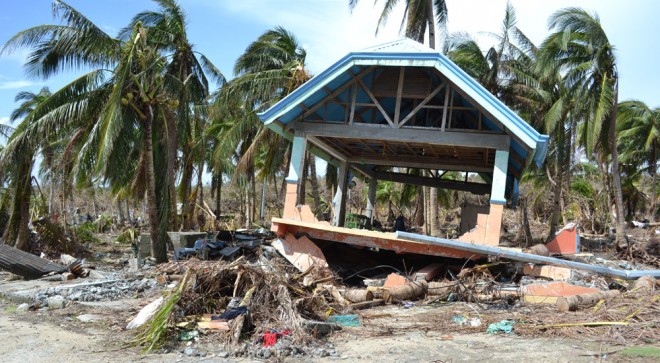Stubborn man almost became lone ‘Yolanda’ fatality in Samar town

Video by INQUIRER.net’s Ryan Leagogo
BALANGKAYAN, Philippines—Balangkayan town in Eastern Samar survived the fury of Supertyphoon “Yolanda” with zero casualty although its two villages were washed out. Municipal engineer Jemsel Valdez would have been the lone fatality if things didn’t go his way, but he learned his lesson the hard way.
“I thought it was just going to be wind. My house could withstand it,” Valdez told INQUIRER.net as he pointed to his home, which was now missing doors, windows and a couple of walls.
Like other survivors, the engineer said he did not anticipate the surge of water from the sea, which equally washed out other communities and killed thousands of people elsewhere.
Two days before, the local government was already calling for pre-emptive evacuation. Mayor Allan Contado said this was followed by forced evacuation the night before the typhoon hit.
“One reason why we really prepared is because this was not the first time that the water rose in our area,” he said. The coastal town of Balangkayan was in the past plagued by strong storms that leveled houses and coconut trees. They have also experienced storm surges, but not as terrifying as what happened last Nov. 8.
Contado, a former National Bureau of Investigation spokesman, said it was the reason why they made sure their evacuation areas were on higher ground.
“This (Yolanda) was a supertyphoon. Hindi biro-biro ito. We really convinced the people (to leave their homes). With God’s mercy, they evacuated,” he added.
But not Valdez.
He said he asked his wife and daughter to evacuate but they wanted to stay with him.
“At around 4 a.m., the waves came…My cousin called me and said they already evacuated, the water was already rising. I looked at our backyard (facing the sea) and thought everything was still fine,” he said.
Nevertheless, he roused his family from sleep and readied their things for evacuation.
His wife was cooking when black water spilled unto the white tiles of their kitchen. In five minutes, the water rushed into their house.
“I was getting our bags when the wave hit us. My wife was slammed into a wall and my daughter separated from us,” he said.
A matter of seconds
In a matter of seconds, their door was blocked by furniture and debris. They were trapped, soaked in chest-deep waters, and Valdez was injured on the leg.
“Something hit me on the leg. I was wounded,” he said, adding that he could not walk for two days after the typhoon.
He could only bring his family to their room, securing them on top of their double-deck bed. There, Valdez thought they were safe, that the water would not rise further.
But when the water suddenly drew back into the sea, bringing with it debris and furniture, he rushed to the door and led his family out of the house.
Running barefoot, they were able to seek refuge in his cousin’s two-story house located farther from the shore. From there, they watched the supertyphoon’s fury as the sea surged with the onslaught of fierce winds and heavy rain.
“If the interval (between the surges) was rapid, perhaps we would not have survived,” he said.
For at least two hours, the large waves continued to wreak havoc on the small town, crushing houses made from light materials and pummeling concrete houses with large debris.
More than two weeks later, Valdez and his other relatives temporarily live in what used to be their houses. With many of the walls destroyed by the surge, they hung tarpaulin to keep them safe from the elements. Relatives lent chairs and other household items.
Leaving the town
“If we are able to raise money, we will leave this place,” a traumatized Valdez said. “It’s terrifying (to think that it will happen again). We’ll move to a higher place.”
Valdez said that if had he known that Balangkayan previously experienced storm surges, he would have listened to the warnings of older residents and evacuated his house at the outset.
“Good thing there were no casualties,” he said.
Nearby, neighbors were helping Fernando and Marilou Ejada rebuild their home.
The couple said all the houses in their neighborhood were swept away by the storm surge that reached as high as the coconut trees. Now, the soil near the coast has been eroded and replaced by sand and pieces of coral.
Marilou Ejada said they might have trouble returning to fishing after they had lost their boat.
She said they would look for a new source of income since it would be difficult for them to raise P5,000 to P6,000 to acquire a new boat.
Asked if they expect help from the government, she said, “Sana.”
Mayor Contado said their primary problem now was lost livelihood and relocation.
Because of the storm surge, boats and rice fields were destroyed, leaving the majority of Balangkayan’s population without a source of income.
Contado said they hope to continuously receive relief goods for three to four months until the farmers are able to harvest again.
“We have stocks of rice to sustain them harvesttime,” he said.
Contado said they will also build fishponds to serve as another source of income for the fishermen, especially during rainy season.
“Then we will be distributing vegetable seeds…equitable distribution to the people, especially those hardest hit by the calamity,” he said.
He said there will be gradual relocation and the rebuilding of infrastructures, including their water system and marine ecological park which was an important source of income for the town.
Related Stories
Chinese hospital ship arrives in Leyte

